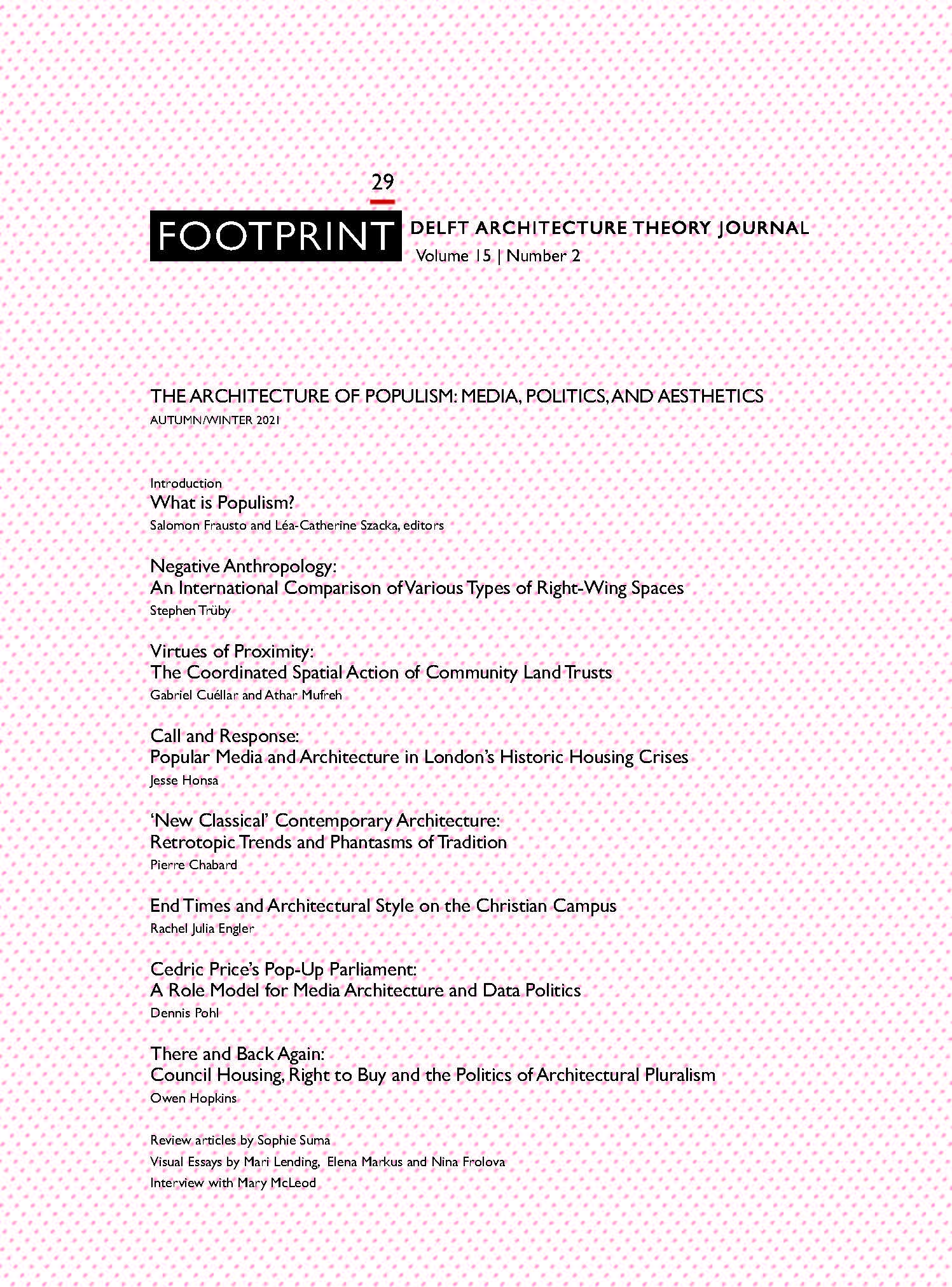Call and Response
Popular Media and Architecture in London's Historic Housing Crises
DOI:
https://doi.org/10.7480/footprint.15.2.5386Abstract
A "housing crisis" is often naively understood as a simple market imbalance between supply and demand, frequently occurring within cities in a capitalist mode of development. If that were the case, the solution would be to simply open the pipes and build more houses, a regulatory action delegated to technocrats. But as Reinhardt Koselleck reveals, crisis is a concept constructed by special interest groups with the aim of challenging absolute power, enlarging a sphere of popular criticism towards business-as-usual. This paper considers the operative nature of 'housing crisis' and related terms by investigating their use as a tool for urban reform in the 19th and 20th centuries in London. In newspaper articles, think tank publications and government reports, criticism often took on qualitative dimensions, leveraging change to housing practices. Crisis itself has had different meanings, from a moral apocalypse to a political risk to an historic opportunity. This is in contrast to how the term is used today, where it is no longer a climactic moment of decision and relief, but a perpetual and seemingly unsurmountable condition. While London's housing crisis is today universally accepted according to experts' statistics, it is rarely addressed on popular aesthetic grounds.
References
Airey, Jack, Sir Roger Scruton and Sir Robin Wales. Building More, Building Beautiful: How design and style can unlock the housing crisis, London: Policy Exchange, 2018.
Althorpe, Mike and Abigail Batchelor. Revolutionary Low Rise: Informing London's Suburban Densification, London: RIBA, 2019.
Amati, Marco and Robert Freestone, "All of London's a State: The 1943 County of London Plan Exhibition", Urban History 43, 4 (2016): 539-556.
Aureli, Pier Vittorio, Leonard Ma, Mariapaola Michelotto, Martino Tattara and Tuomas Toivonen, “Promised Land: Housing from Commodification to Cooperation”. E-Flux: Collectivity (2019), https://www.e-flux.com/architecture/collectivity/304772/promised-land-housing-from-commodification-to-cooperation/
Beames, Thomas. The Rookeries of London: Past, Present and Prospective. London: Thomas Bosworth, 1852.
Birbeck, David, "Back to the back-to-back", Architecture Today, 2018. https://www.architecturetoday.co.uk/back-to-the-back-to-back/
Block, India, “UK's new commission for beautiful buildings is 'tedious hangover from 1980s' say architects”, Dezeen. (6 November 2018) https://www.dezeen.com/2018/11/06/building-better-building-beautiful-commission-uk-architects-react-news/
Boughton, John. Municipal Dreams. London: Verso Books, 2018.
Boys Smith, Nicholas, "Building Beautiful: an interview with Nicholas Boys Smith", Roger Scruton Legacy Foundation (28 September 2020) https://www.youtube.com/watch?v=2EzUSrCxLOk
Building Better, Building Beautiful Commission, Living With Beauty: Promoting health, well-being and sustainable growth .UK Ministry of Housing, Communities & Local Government, January 2020.
Bullock, Nicholas. Building the Post-War World: Modern Architecture and Reconstruction in Britain. London: Routledge, 2002.
Cole, William. "Up to 1.5 million modern flats could be unmortgageable", The Daily Mail, 20 September 2020. https://www.dailymail.co.uk/news/article-8752581/Modern-flats-unmortgageable-amid-crisis-building-safety.html
Create Streets, https://www.createstreets.com/front-page-2/about-us/our-story/
Desmond, Shaw, "Mobilise the Nation for House Production, The London Magazine 44, August 1920, 110.
Dickinson, Foster, "Homes Not Shelters", Tribune (4 February 1944), 6.
Dyos, H.J., “The Slums of Victorian London”, Victorian Studies vol. 11 no. 1 (1967): 5-40.
Engels, Friedrich. The Housing Question. Moscow: Progress Publishing, 1970, www.marxists.org/archive/marx/works/1872/housing-question/index.htm
Evans, Rebecca, “Will a greedy landlord turn the house next door to you into an overcrowded slum? It's happening more and more - even in the nicest neighbourhoods”. The Daily Mail, 2 May 2017, https://www.dailymail.co.uk/news/article-4464278/Greedy-landlord-turns-house-overcrowded-slum.html
Evans, Robin, “Rookeries and Model Dwellings”, in Translations from Drawing to Building and Other Essays. London: Architectural Association, 1997.
Farha, Leilani "Guidelines for the Implementation of the Right to Adequate Housing", United Nations Human Rights Council, 30 March 2020.
Downloads
Published
Issue
Section
License
Copyright (c) 2022 Jesse Foster Honsa

This work is licensed under a Creative Commons Attribution 4.0 International License.
- Authors retain copyright and grant the journal right of first publication with the work simultaneously licensed under a Creative Commons Attribution License that allows others to share the work with an acknowledgement of the work's authorship and initial publication in this journal.
- Authors are able to enter into separate, additional contractual arrangements for the non-exclusive distribution of the journal's published version of the work (e.g., post it to an institutional repository or publish it in a book), with an acknowledgement of its initial publication in this journal.





